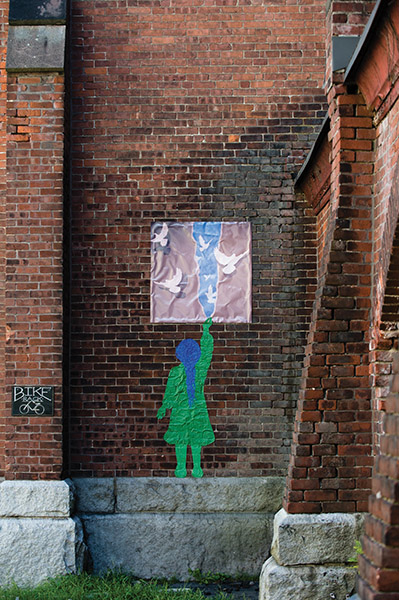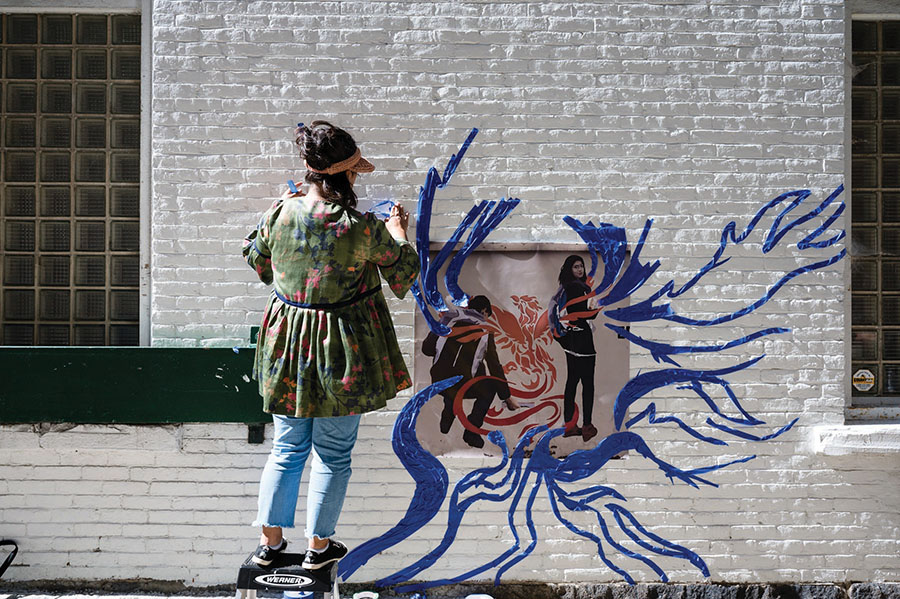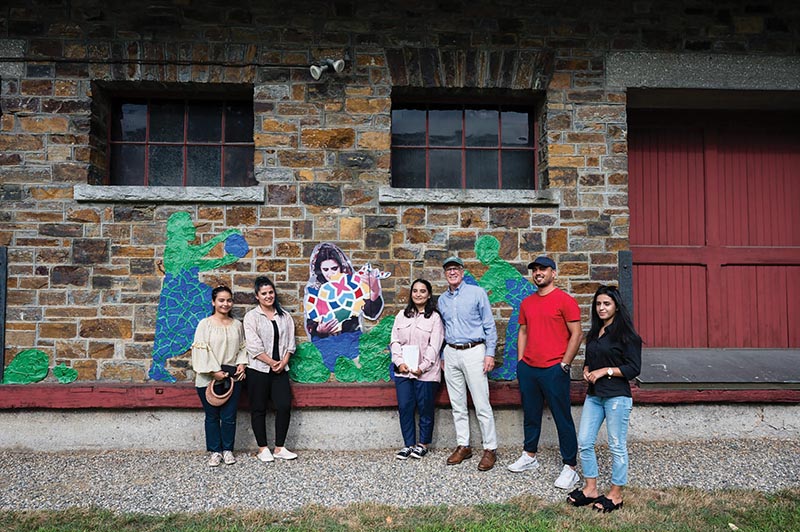Honoring Honar
The ArtLords, an Afghan Artists Collective, Recreates Murals in Brattleboro

It’s been over a year since the chaotic departure of American forces from Afghanistan following two decades of a losing battle in keeping the Taliban at bay. Although the American presence produced some gains for women’s rights, education, and artistic expression, the Taliban made squelching those freedoms a priority as soon as they regained power. As evidence of both their fear of art and the power of art, one of the Taliban’s first actions was to whitewash colorful murals that had been painted on blast walls across the nation’s capital, Kabul. The murals had been created by the ArtLords, a grassroots group of over 100 artists and volunteers who believed that images in public places could effect social transformation and create positive change. The artists fearlessly addressed politically sensitive issues in their public depictions of feminist concerns and examples of the trauma that decades of war left on the Afghan people.

As it became clear in 2021 that there was no longer artistic freedom in Afghanistan, members of the ArtLords joined thousands of refugees seeking asylum in the United States and in other accessible neighboring countries. Five of those refugee artists, Marwa, Negina, Meetra, Zuhra, and Abdullah (last names are not used for their safety) found themselves relocated to Brattleboro, VT, where they were welcomed by the local community and where their abilities found support at the Brattleboro Museum of Art. Those abilities recently took the form of Honoring Honar, a collaborative, pop-up mural project created by the ArtLords, Tape Art, Brattleboro Museum & Art Center, and other community partners, that was held on the streets of Brattleboro during the month of August 2022.
Honar means art in Dari, the officially recognized language of Afghanistan, also known as Afghan Persian, or Farsi. During the American occupation of Afghanistan, embassies, schools, and other government buildings in Kabul were protected from attack by huge, concrete barrier walls, designed to keep the people inside those walls safe. The prison-like walls also sent a message to the Afghan people that they were on their own as far as safety was concerned, creating enclaves of privilege and power inside while danger stalked the streets. These walls also presented a window of opportunity for long repressed creative expression among Afghanistan’s artists.
The Taliban has a well-documented history of banning images of the human form and destroying cultural artifacts as they had done with the horrific demolition in 2001 of the giant carved Buddhas of Bamiyan. In 2014, when it appeared that the Americans were sending signals that they may not stay forever and a corrupt Afghan government was gaining control, two artists, Omaid Sharif and Kabir Mokamel co-founded ArtLords. A word play on war lords and drug lords, the ArtLords wanted to make public opinion visible by transforming the dull, grey concrete surface of the blast walls into platforms for arresting imagery that would inspire people to think and discuss the issues they depicted. Their first mural was a pair of huge eyes and the words “I see you.” The aim was to create dialogue while sending a message to the corrupt government that their treachery would not go unnoticed. From 2014 until the shameful embarrassment of the American military abandonment of Afghanistan in 2021, the ArtLords painted more than 2,000 murals in 19 of Afghanistan’s 34 provinces. Some of the work was funded by UN agencies and other NGOs with the aim of promoting peace and to raise awareness of positive development initiatives. With the return of the Taliban, the clock has been turned back and any progress that was gained is again being erased.
Kirsten Martsi, the Brattleboro Museum & Art Center’s manager of education and community engagement, has a history of working with refugee artists in other communities throughout the region. She spoke enthusiastically about the positive impact refugees have had in revitalizing cities like Utica, NY, and Worcester, MA, which is home to the biggest refugee resettlement program in that state. Martsi has seen the seeds of a similar embrace of refugees in Brattleboro, partially the result of the visibility created through the Honoring Honar mural project. She has observed, “Art brings people together and helps to cross boundaries that official and often partisan forms of communication find difficult to achieve.”

Originally it was the refugee resettlement community that reached out to the museum. They arranged for the Afghan artists to visit the museum and that helped to reignite their passion for their work and instigated the discussions and collaboration with the founders of Providence, RI-based Tape Art, Michael Townsend and Leah Smith. Since temporary murals lower the risk factor for owners of public buildings who needed to give permission for such a project, Tape Art was seen as providing an ideal solution. Practiced by an ever-evolving group, Tape Artists have worked on projects worldwide to create temporary large scale public art murals and installations made with a special type of low adhesive tape. They are designed to be removed shortly after completion.
With that collaboration, 17 large murals were recreated throughout Brattleboro in five days using fragments of the ArtLords original work that had been destroyed as their inspirational starting points. To help interested viewers navigate the project, maps were created with QR codes linked to images of the originals in Afghanistan. Over the course of two weeks in August the murals attracted visitors from all over the state. Sharif traveled from his home in Virginia to see the murals. The artists found the physicality of working with this medium demanded new ways to think about drawing and creating texture. The experience for them was cathartic.

Artists Negina and Abdullah have become enthusiastic spokespersons for the group. Negina left Afghanistan with only a small backpack filled with the three things most important to her–a sketchbook, pen, and paints—because she believed in the power of art. Abdullah has been practicing art in Afghanistan since he was a child. When asked what he knew about Vermont before coming here he said, “I knew a little about it, like about its nature, the artistic town, liberal town, open minded people and very welcoming to immigrants.” Although both Negina and Abdullah regretted having to take the Honoring Honar murals down, they enjoyed being able to make art again and “to be themselves.” Negina says the project fills her with pride and joy though at the same time, she’s despondent about the situation in Afghanistan. In his plans for the future Abdullah hopes, “To do a lot of collaborative murals, artworks in the town and the region, and to expand the field of art in my life in other areas as well apart from visual arts.”

So far, the success of Honoring Honar is opening new opportunities from both the private and public sector for these ambitious young artists to earn a sustainable income through commissions and other paid forms of work. The Vermont Folklife Center hired them to participate in their summer youth program and two new mural projects are in the works. A pop-up traveling exhibition is being planned to include refugee artists personal artworks sometime this fall. Martsi says, “There’s a lot of unknowns in this work, but it’s exciting to see progress. These young artists have been through a lot of trauma but they can use their talents to process their trauma and share their experiences with the world through art.”
